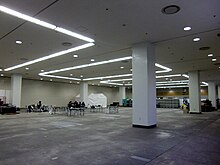

This article needs additional citations for verification. Please help improve this articlebyadding citations to reliable sources. Unsourced material may be challenged and removed.
Find sources: "Recessed light" – news · newspapers · books · scholar · JSTOR (May 2016) (Learn how and when to remove this message) |

Arecessed lightordownlight (also pot lightinCanadian English, sometimes can light (for canister light) in American English) is a light fixture that is installed into a hollow opening in a ceiling. When installed it appears to have light shining from a hole in the ceiling, concentrating the light in a downward direction as a broad floodlight or narrow spotlight.

"Pot light" or "canister light" implies the hole is circular and the lighting fixture is cylindrical, like a pot or canister.
There are three parts to a recessed lighting fixture: housing, trim and bulb. The trim is the visible portion of the light. It is the insert that is seen when looking up into the fixture, and also includes the thin lining around the edge of the light.[1] The housing is the fixture itself that is installed inside the ceiling and contains the lamp holder. There are many different types of bulbs that can be inserted into recessed lighting fixtures, with the amount of heat generated by the bulb being a unique consideration.
The earliest recessed lights were developed in the 1940s by Ivan Kirlin of the Kirlin Company, Detroit, Michigan.[2]
Recessed lighting offers the advantages of being a hidden light source and energy efficiency[citation needed]. However, the tradeoff is that they are relatively permanent and may be unflattering.
InNorth America, UL 1598 recessed housings generally fall into one of four categories.
The main feature of the housing is designed to ensure that no flammable materials come into contact with the hot lighting fixture. Badly-housed downlights can be a fire hazard, though all newer ones contain a self-resetting thermal switch for safety.
The housings come in various sizes based on the diameter of the circular opening where the lamp is installed. The most commonly used sizes are 4, 5 and 6 inches in diameter, with 4 inch IC New Construction units less readily available at present. Smaller housings (2 and 3 inch) are also available for specialized uses.
The housing can also be "Air Tight", which means it will not allow air to escape into the ceiling or attic, thus reducing both heating and cooling costs.
The City of Chicago has an additional requirement, "Chicago Plenum", which requires the housing to be airtight in addition to requiring all wiring and to be sealed off and gasketed from the plenum air space. This housing rating must be used on all recessed luminaires installed in air plenums in the City of Chicago as well as nearby municipalities which have adopted the Chicago amendments to the NEC. The intent of this rating is to prevent potential sparks from escaping the luminaire into the air plenum and getting recirculated in the HVAC system.[3]
IEC 60598 has two classifications.
Recessed lighting styles have evolved with more manufacturers creating quality trims for a variety of applications. Recessed lighting trim usually comes in the standard baffle in black or white, which is the most popular.[citation needed] They are made to absorb extra light and create a crisp architectural appearance.
There are cone trims which produce a low-brightness aperture. Multipliers are offered which are designed to control the omnidirectional light from "A" style incandescent light bulbs and compact fluorescents.
Lens trim is designed to provide a diffused light and protect the lamp. Lensed trims are normally found in wet locations.
The luminous trims combine the diffused quality of lensed trim but with an open downlight component.
Adjustable trim allows for the adjustment of the light whether it is eyeball style, which protrudes from the trim or gimbal ring style, which adjusts inside the recess. These lights allow for full versatility.[4]
Lastly, there are the wall-washer trims, which are designed to eliminate the often seen "scalloped light effect".
There are two types of bulbs for recessed lighting: directional and diffuse. Directional lamps (R, BR, PAR, MR) contain reflectors that direct and control the light. Diffuse lamps (A, S, PS, G) control light distribution through their omnidirectional light.[5]
|
| |||||||||||||
|---|---|---|---|---|---|---|---|---|---|---|---|---|---|
| Concepts |
| ||||||||||||
| Methods of generation |
| ||||||||||||
| Stationary |
| ||||||||||||
| Portable |
| ||||||||||||
| Automotive |
| ||||||||||||
|
| ||||||||||||
|
|
| ||||||||||||
|
| ||||||||||||
| Related topics |
| ||||||||||||